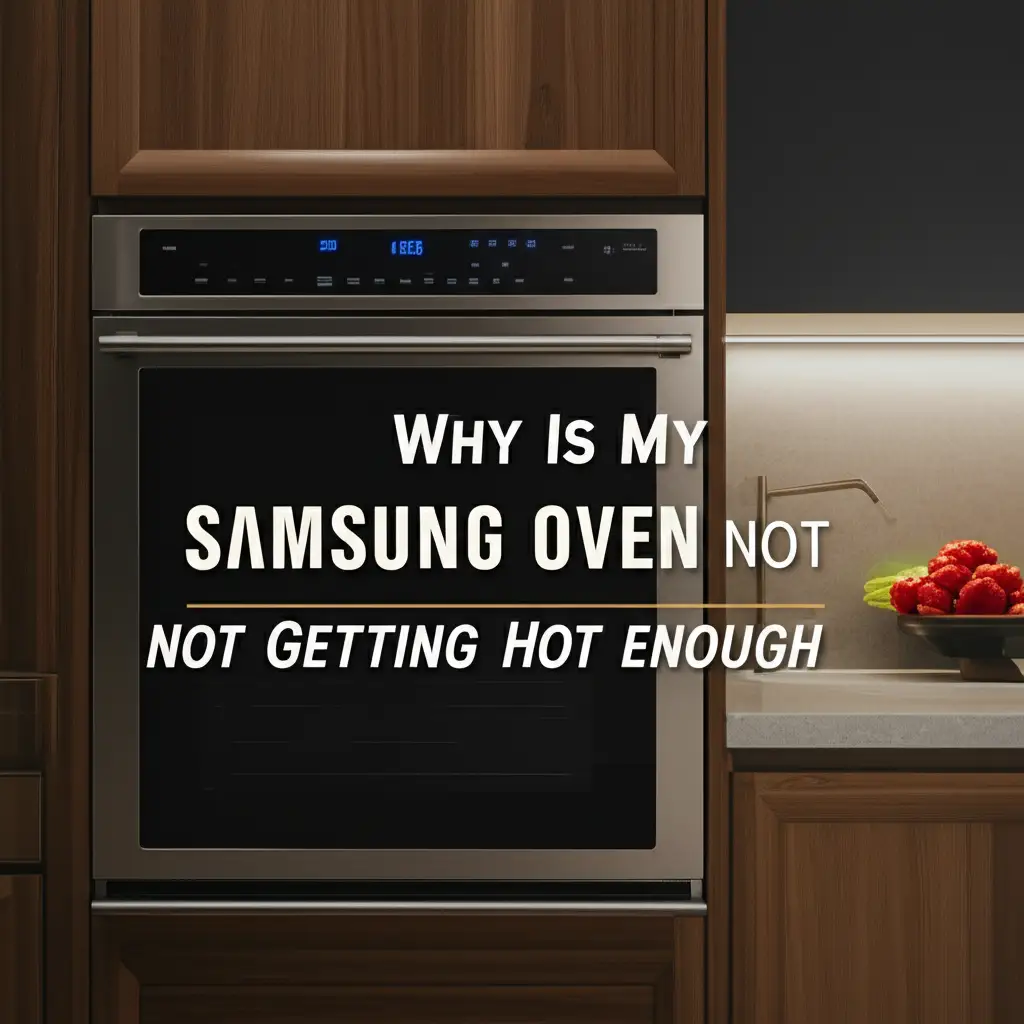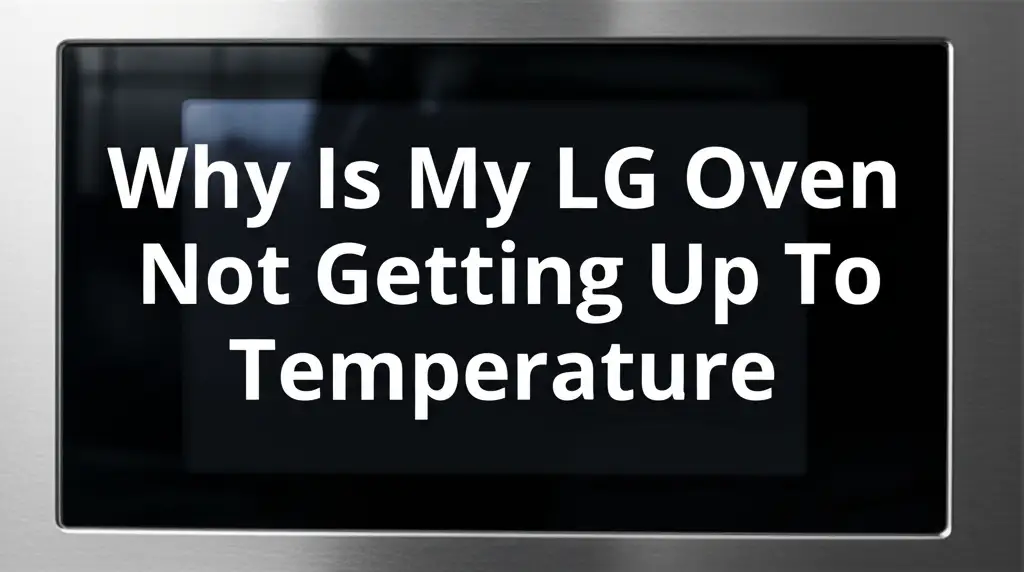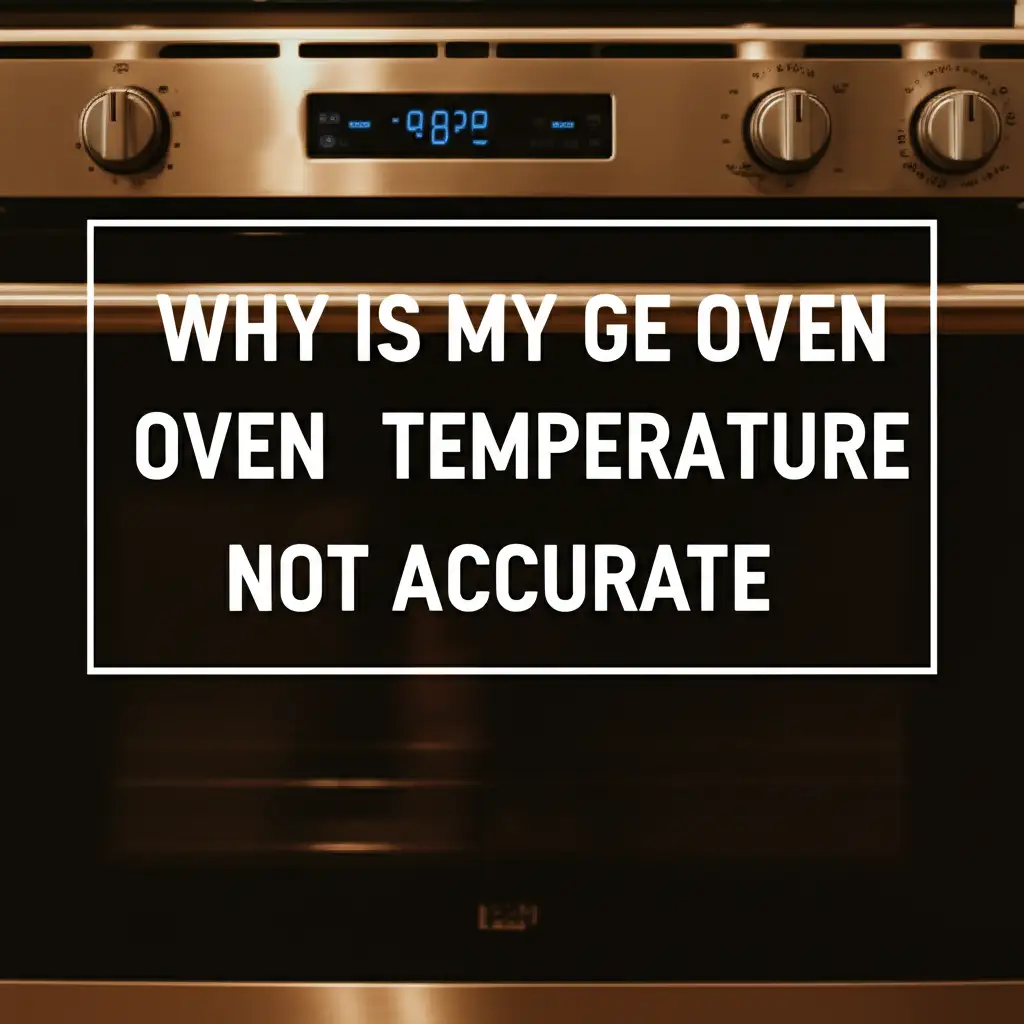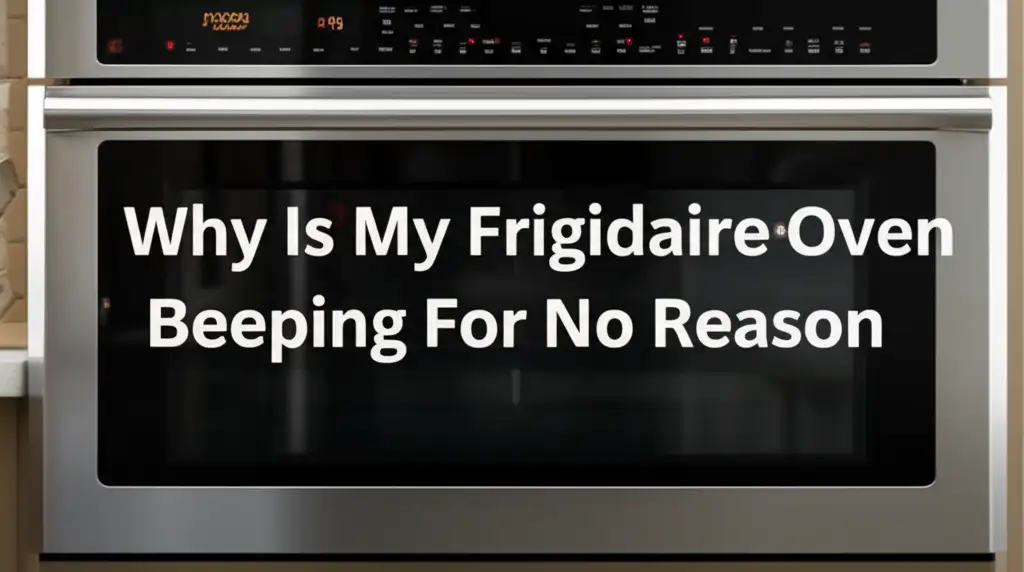· Katria Melrose · Appliance Repair · 18 min read
Why Is My Samsung Oven Not Getting Hot Enough

Troubleshooting Your Samsung Oven Not Getting Hot Enough
It’s truly frustrating when you plan a meal, preheat your oven, and find it just isn’t reaching the right temperature. If you own a Samsung oven and are experiencing this common problem of it not getting hot enough, you are in the right place. An oven that does not heat properly impacts baking results, extends cooking times, and can even ruin your food. We rely on our appliances to perform as expected, and a malfunctioning oven can disrupt daily routines. I understand this inconvenience completely; I have faced it myself.
This guide will walk you through the most common reasons why your Samsung oven might not be heating adequately. We will explore simple diagnostic steps you can take at home. We will also cover solutions for issues ranging from faulty heating elements to temperature sensor problems, and even concerns with gas supply or door seals. My goal is to help you identify the specific cause and provide clear, actionable steps to get your Samsung oven working perfectly again. Let us get your kitchen back in proper order.
Takeaway
- Check the Heating Elements: Inspect both bake and broil elements for visible damage like breaks or blisters.
- Test the Temperature Sensor: Use a multimeter to check the resistance of the sensor, comparing it to manufacturer specifications.
- Inspect Gas Oven Igniter and Supply: For gas models, ensure the igniter glows and gas flows correctly.
- Verify Door Seal and Hinge Condition: A worn door gasket or misaligned hinges allow heat to escape.
- Reset the Oven: Sometimes a simple power cycle can resolve minor electronic glitches.
- Consider Control Board Issues: If other components are fine, the control board may be faulty, requiring professional attention.
Why is my Samsung oven not getting hot enough? Your Samsung oven may not get hot enough due to a faulty heating element, a defective temperature sensor, a worn-out door seal, or issues with the igniter in gas models. Less common causes include problems with the control board or improper oven calibration. Identifying the specific component at fault is the first step toward fixing the issue.
Understanding Common Causes for Samsung Oven Heating Issues
When your Samsung oven fails to reach its set temperature, it can stem from several common problems. Recognizing these issues is the first step toward finding a solution. We depend on our ovens for consistent performance. This is why a heating problem can be so disruptive. Understanding the typical culprits will help you diagnose the problem efficiently.
Many times, a simple component failure is behind the issue. For instance, an electric oven relies on heating elements to generate warmth. If these elements burn out, the oven cannot heat properly. Similarly, a temperature sensor ensures the oven maintains the correct heat. If it sends incorrect readings, the oven’s internal temperature will be off. These parts wear out over time with regular use.
Gas ovens have different systems that can fail. A faulty igniter in a gas oven prevents the gas from lighting. This means no heat production. The gas supply itself could also have problems. An issue with the gas valve or supply line will also prevent the oven from getting hot. Safety mechanisms are in place to prevent gas leaks, so they will stop the flow if a problem is detected.
The oven door seal plays a crucial role in maintaining temperature. If the seal is loose or damaged, heat escapes. This forces the oven to work harder, yet it still struggles to reach the set temperature. A proper seal keeps hot air inside the cavity. A strong door seal also helps the oven preheat faster. You can test your oven’s preheating speed to see if this is a factor. Why Does My Samsung Oven Take So Long To Preheat details this issue.
Finally, the oven’s control board acts as its “brain.” It manages all functions, including temperature regulation. If the control board malfunctions, it might send incorrect signals to the heating components. This leads to erratic heating or no heat at all. Sometimes, a power surge can damage this sensitive component. We will explore each of these issues in more detail later.
Diagnosing a Faulty Heating Element in Your Samsung Oven
A common reason your Samsung electric oven does not get hot enough is a faulty heating element. Electric ovens have two main heating elements: the bake element at the bottom and the broil element at the top. Both contribute to maintaining the oven’s temperature. If either one is not working, the oven will struggle to reach the desired heat. Identifying a problem with these elements is often straightforward.
First, visually inspect both the bake and broil elements. Look for any visible signs of damage. A properly functioning element should glow red when heated. If you see a break, crack, blister, or a dark spot on the element, it is likely faulty. A visible burn mark often indicates a complete failure. Make sure the oven is off and cool before you touch any part.
If no damage is visible, you can use a multimeter to test the element’s continuity. This process checks if an electrical circuit is complete. First, unplug your oven from the power source for safety. Access the heating element connections, usually at the back of the oven. Disconnect the wires leading to the element. Set your multimeter to the Rx1 setting or continuity mode. Place one probe on each terminal of the heating element.
A good heating element should show a resistance reading between 10 to 30 ohms. If your multimeter shows an “open” circuit or an infinite resistance (OL), the element is broken. This means electricity cannot flow through it. Therefore, it cannot generate heat. A reading of zero ohms might also indicate a short circuit, which is also a fault. In such cases, the element needs replacement. Replacing a heating element is a relatively simple DIY repair for many oven owners. However, always ensure you use a genuine Samsung replacement part. You can compare this process to other oven brands, like when troubleshooting a Whirlpool oven. Why Is My Whirlpool Oven Not Getting Up To Temperature covers similar diagnostic steps.
Checking the Oven Temperature Sensor for Accuracy
The oven temperature sensor plays a critical role in how hot your Samsung oven gets. This small component monitors the internal temperature of the oven cavity. It sends readings to the control board. The control board then adjusts the heating elements or gas valve to maintain the set temperature. If the sensor provides inaccurate readings, the oven’s heating cycle will be incorrect. This results in an oven that is either too hot or, in our case, not hot enough. Sometimes, an oven can even become too hot if the sensor fails to report correctly. Oven Is Too Hot Troubleshooting discusses this opposite problem.
You can often locate the temperature sensor inside the oven cavity, usually at the top left or right rear wall. It looks like a thin metal rod sticking out. Before testing, always ensure the oven is unplugged from the power supply for safety. Carefully remove the sensor from its mounting bracket. You may need to unscrew it. Disconnect the wiring harness.
Use a multimeter to test the resistance of the temperature sensor. Set your multimeter to the ohms (Ω) setting. Place the probes on the two terminals of the sensor. A typical oven temperature sensor should show a resistance of around 1080 to 1100 ohms at room temperature (about 70-75°F or 21-24°C). This value can vary slightly by model, so consulting your Samsung oven’s service manual provides the exact specification.
To further test its accuracy, you can perform a cold water or hot water test. Place the sensor in a glass of ice water (32°F/0°C) and check the resistance. Then, place it in a glass of very warm water and check again. The resistance should change significantly with temperature. A working sensor’s resistance increases as the temperature rises. If the sensor shows an open circuit (OL) or a resistance value far from the expected range, it is faulty. A consistent but incorrect reading also means it is bad. Replacing a defective temperature sensor is generally a straightforward repair. It often restores the oven’s ability to maintain accurate temperatures.
Issues with the Igniter and Gas Supply in Samsung Gas Ovens
If you have a Samsung gas oven and it is not getting hot enough, the problem likely lies with the igniter or the gas supply. Unlike electric ovens with heating elements, gas ovens use an igniter to light the gas. Once lit, the gas flame produces the heat needed for cooking. A malfunctioning igniter or an interrupted gas flow prevents the oven from heating properly. This is a common issue for gas appliances.
First, check the igniter. When you set your gas oven to bake, listen for the click of the igniter. Then, look inside the oven cavity. The igniter should glow brightly, indicating it is drawing enough current to heat up and ignite the gas. If it glows dimly, or not at all, it may be too weak to ignite the gas consistently. A weak igniter will often allow gas to flow for a few seconds before shutting off due to a lack of flame. This means the oven gets some gas but no sustained heat.
To confirm an igniter issue, you can safely observe its operation. Set the oven to a bake temperature. Watch the igniter. If it glows for 30-60 seconds without igniting the gas, or if it glows weakly, it is likely faulty. A multimeter can also test the igniter’s continuity and resistance. A good igniter typically has a resistance between 60 to 600 ohms, depending on the type (hot surface igniter vs. glow bar igniter). Always consult your oven’s specific service manual for exact resistance values. Disconnect the oven from the power and gas supply before testing. You should also ensure the gas supply valve to the oven is fully open.
Problems with the gas supply itself can also cause low heat. This could be due to a partially closed gas valve, a kinked gas line, or even an issue with your home’s main gas supply. If other gas appliances in your home (like your stove top or water heater) also show low flame, contact your gas utility company immediately. A faulty gas valve on the oven itself can prevent proper gas flow. This requires professional diagnosis and repair. Working with gas lines can be dangerous. If you suspect a gas leak or a major gas supply problem, always call a certified professional. Never attempt to repair gas lines yourself. This is a critical safety consideration.
Examining Your Samsung Oven’s Door Seal and Hinge Integrity
The oven door seal, also known as the gasket, is a simple yet crucial component that impacts your Samsung oven’s heating efficiency. Its purpose is to create a tight seal between the oven door and the oven cavity. This seal prevents hot air from escaping during cooking. If the door seal is damaged, worn, or improperly seated, heat will leak out. This makes the oven struggle to reach and maintain the desired temperature. It also wastes energy.
To check the door seal, visually inspect it all around the oven door frame. Look for any cracks, tears, brittle spots, or missing sections. A healthy door seal should be soft, pliable, and intact. If it feels stiff or has noticeable gaps, it is likely compromised. You can also perform a simple “paper test.” Close the oven door on a piece of paper, half inside and half outside. Try to pull the paper out. If it slides out easily, the seal in that spot is weak. Repeat this test around the entire perimeter of the door.
Beyond the seal, the oven door hinges also play a role in maintaining a good seal. If the hinges are bent, loose, or misaligned, the door will not close properly. This creates gaps even if the seal itself is in good condition. Open and close the oven door a few times. Feel for any excessive play or wobbling. Check if the door sags when fully open. If the door does not close flush with the oven frame, the hinges may need adjustment or replacement. This is less common but still a possibility.
Replacing a damaged door seal is a straightforward repair. Most seals are friction-fit or held by small clips. You can usually pull the old one out and push the new one into place. Make sure to buy a genuine Samsung replacement seal specific to your oven model. This ensures a perfect fit. If the hinges are the problem, it can be a more involved repair. You might need to adjust them or replace the hinge assemblies. Addressing a faulty door seal or hinge issue often resolves temperature problems without needing to replace more expensive components. A properly sealed oven maintains consistent heat, leading to better cooking results and energy efficiency.
Troubleshooting the Oven’s Control Board and Thermostat
When other common causes like heating elements, temperature sensors, or gas igniters check out fine, the problem might stem from your Samsung oven’s control board or thermostat. These two components work together to regulate temperature. The control board acts as the central processing unit, interpreting user commands and sending signals to various oven parts. The thermostat, often integrated into the control board or a separate component, directly manages the heating cycle based on the temperature sensor’s input.
A faulty control board can manifest in various ways. It might display error codes, become unresponsive, or simply fail to send the correct voltage to the heating elements or gas valve. If the control board is sending an insufficient voltage to the heating element, the element will not get hot enough, or it will take an unusually long time to preheat. This can also explain why your Samsung oven might turn off unexpectedly. Why Does My Samsung Oven Turn Off When I Open The Door describes a related issue that could be caused by the control board’s misinterpretation of sensor data or a short.
Diagnosing a control board issue often involves eliminating other possibilities first. Since the board controls multiple functions, a general lack of heat or erratic behavior across different settings can point to it. You might notice inconsistent temperatures during cooking cycles. For example, your oven might heat well for a while, then drop significantly, even if the set temperature remains the same. Sometimes, a power surge can damage the control board’s delicate circuitry, causing it to malfunction. There is no simple test for a control board’s health that a homeowner can perform without specialized equipment.
The thermostat, or the temperature regulation circuit on the control board, ensures the oven cycles on and off to maintain the set temperature. If this component is faulty, it might not signal the heating elements to turn on frequently enough or stay on long enough. This results in the oven perpetually running at a lower temperature than desired. Replacing a control board is typically a more complex and expensive repair than changing an element or sensor. It usually requires a professional appliance technician. Before considering a control board replacement, try a hard reset of your oven. Unplug it from the power outlet for a few minutes, then plug it back in. This can sometimes clear minor electronic glitches and restore proper function. If the problem persists after a reset and other components are fine, then a control board issue is a strong possibility.
Considering Professional Repair for Persistent Samsung Oven Problems
After attempting the troubleshooting steps yourself, you might find your Samsung oven still isn’t getting hot enough. At this point, it is wise to consider calling a professional appliance repair technician. While many minor issues are DIY-friendly, some problems require specialized tools, in-depth knowledge, or pose safety risks. Trying to fix a complex electrical or gas issue without proper training can be dangerous.
Professional technicians have the expertise to diagnose accurately. They use advanced diagnostic equipment to pinpoint the exact problem, often much faster than a homeowner can. They are familiar with Samsung oven models, common failure points, and specific manufacturer guidelines. This allows them to identify issues that might not be obvious to an untrained eye. For example, they can determine if a delicate wire connection is loose or if a component has an intermittent fault. They also carry a wide range of replacement parts, which means they can often fix the problem on the first visit.
When is it time to call a professional?
- Gas Oven Issues: Any problem involving the gas supply, gas valve, or persistent igniter issues should prompt a call to a professional. Gas leaks are serious safety hazards.
- Complex Electrical Problems: If you suspect a control board malfunction, wiring issues, or anything beyond a simple element replacement, professional help is best. These parts are expensive and complex.
- Lack of Tools or Experience: If you do not have the necessary tools (like a multimeter) or feel uncomfortable working with electrical components or gas, do not risk it.
- Persistent Problem: If you have replaced parts based on your diagnosis and the problem recurs, a professional can offer a fresh perspective.
- Warranty: If your Samsung oven is still under warranty, attempting DIY repairs might void it. Check your warranty terms before proceeding with any repairs yourself.
A professional technician can also advise you on whether the repair is cost-effective. Sometimes, the cost of parts and labor for a major repair can approach the price of a new oven. In such cases, they might recommend replacement instead. While paying for a service call adds to the cost, it ensures the repair is done safely and correctly. It also gives you peace of mind knowing your oven is working efficiently and safely again. They also address issues that impact efficiency, which might be similar to issues in other brands, like LG ovens not heating. Why Is My LG Oven Not Getting Up To Temperature covers troubleshooting steps that mirror many of the professional’s approaches for different brands.
FAQ Section
Q1: Why is my Samsung oven preheating very slowly?
A slow preheat in your Samsung oven often indicates a weakened heating element or a faulty temperature sensor. The element may not be generating enough heat, or the sensor might be reporting inaccurate temperatures to the control board, causing it to prolong the heating cycle. Inspect the elements for visible damage and consider testing the temperature sensor with a multimeter.
Q2: Can a dirty oven affect its heating performance?
Yes, a very dirty oven can affect its heating performance. Heavy grease and food buildup can act as insulation, preventing heat from properly radiating within the oven cavity. This buildup can also clog vents or even interfere with the temperature sensor’s ability to read accurately. Regular cleaning of your oven helps maintain optimal heating.
Q3: How do I reset my Samsung oven’s temperature settings?
To reset your Samsung oven’s temperature settings, first try a simple power cycle. Unplug the oven from its power outlet for about 5-10 minutes, then plug it back in. This hard reset can clear minor electronic glitches. If the oven has a calibration setting, you can adjust it through the control panel menu, typically found under ‘Settings’ or ‘Calibration’. Consult your user manual for specific steps.
Q4: My Samsung electric oven doesn’t heat, but the broiler works. What’s wrong?
If your Samsung electric oven’s broiler works but the bake function does not heat, the problem almost certainly lies with the bake heating element. Since the broil element functions, electricity is reaching the oven’s internal components. This strongly suggests the bake element itself has failed or has a broken internal coil, requiring replacement.
Q5: Is it safe to use my Samsung oven if it’s not heating properly?
Using your Samsung oven when it is not heating properly is generally safe, assuming there is no gas leak or sparking. However, it will not cook food safely or effectively. Undercooked food can pose health risks. Gas leaks, indicated by a strong sulfur smell, are extremely dangerous and require immediate action to turn off the gas and evacuate. For electric models, continuous underheating mostly affects cooking quality.
Q6: How often should I calibrate my Samsung oven?
You do not typically need to calibrate your Samsung oven unless you notice a consistent difference between the set temperature and the actual internal temperature. You can verify this with an independent oven thermometer. If your baking results are consistently off (e.g., always undercooked or overcooked at the suggested temperature), then calibration is advisable. Most ovens only need calibration if parts have been replaced or if significant performance issues arise.
Conclusion
Discovering your Samsung oven is not getting hot enough can be a major inconvenience. It disrupts meal plans and affects your cooking results. We have explored the most common culprits behind this frustrating problem. These include faulty heating elements, inaccurate temperature sensors, issues with the gas igniter or supply in gas models, and problems with the oven door seal or hinges. Even the sophisticated control board can sometimes be the cause.
By systematically troubleshooting these areas, you can often pinpoint the exact issue. Simple visual inspections, along with basic multimeter tests, empower you to diagnose many of these problems yourself. Remember to always prioritize safety by unplugging your oven before any internal inspections or repairs. Replacing a heating element or temperature sensor is often a straightforward fix for many homeowners.
However, some issues, especially those involving gas lines or complex electrical control boards, require professional expertise. Do not hesitate to call a certified technician if you are uncomfortable, lack the right tools, or if your efforts do not resolve the problem. Getting your Samsung oven back to optimal temperature ensures perfectly cooked meals and a more efficient kitchen. Take these steps and regain control of your culinary experience. Your delicious dishes await!
- Samsung oven
- oven not heating
- oven troubleshooting
- oven repair
- oven temperature problems
- electric oven
- gas oven





